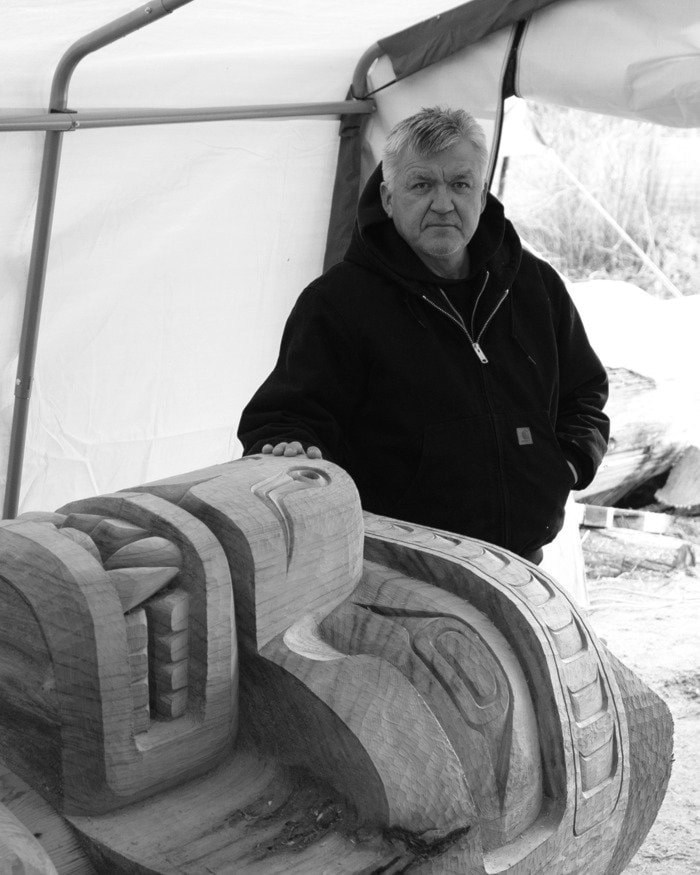FORT RUPERT—A local carver has completed his most ambitious project, a 42-foot, 10-inch totem pole that was nearly a year in the making.
But the brightly decorated cedar log still has a long road to travel.
Stan Hunt and a crew of family members and other volunteer workers loaded the pole, estimated at between 7,000 and 8,000 pounds, onto a flatbed Saturday at his backyard “studio.”
It then began a meandering journey that will end with the pole being raised in Canada Square in Buenos Aires, Argentina, and dedicated in a ceremony on Canada Day.
“It could be a life-changing event, to tell you the truth,” said Hunt, whose largest previous totem was a 20-foot pole that stands at the nearby health clinic.
“It might be, could be. I kind of think it is, just by the way the computer is going crazy these days.”
With ravens and crows circling and calling overhead, Hunt and his crew used a truck-mounted crane to lift the brightly coloured pole onto a 32-foot flatbed trailer. He and his nephew, truck driver James Hunt, departed early Sunday morning on a trip that included stops in Campbell River, the Shady Rest in Qualicum, Nanaimo and finally Victoria before ferrying to the mainland.
Once there, he parked the truck for a short while in Vancouver before taking the pole on to Surrey to be loaded for its five-week freighter trip to the Southern Hemisphere.
The pole will replace a previous pole, carved by his grandfather Mungu and father, Raymond, which was erected in Buenos Aires in 1962.
When that pole was brought down for renovation a little more than a year ago, it was found to be too badly deteriorated to restore, to the great disappointment of Argentina’s aboriginal community.
Working through the Canadian embassy, officials sought out the Hunt family to learn whether any family members still carved. Eventually, Stan was hired to create a replacement pole which will continue the connection between his family and the Kwakiutl people with the South American country.
“I know it would mean a lot of other things to our Kwakiutl people, but for me, personally, this pole is about my own personal family,” said Hunt.
At its base is a double-headed Sisiutl representing Hunt’s grandmothers. Above is a grizzly holding a halibut to represent Hunt and his family. Atop the bear is the first of two chiefs, representing his grandfather Mungu, and Mungu holds a frog copper to acknowledged his adoption of Stan’s mother, a frog woman.
Next is a large killer whale, the family crest of Stan’s wife Lavina, who hails from Alert Bay. Then comes the raven, with a large pair of wings, denoting the Hunt family crest, and, finally, a second chief representing Stan’s father Raymond a noted carver and artist who worked for years with the Royal Museum in Victoria.
At the pole’s base, Hunt has carved his family name and attached a copper plate, his nod to the tradition of laying a piece of copper during pole-raising ceremonies to mark the status and power of the family raising the pole.
The totem pole was also a family project. Stan’s sons, Jason and Trevor, were involved from the beginning. And Stan Hunt said other family members dropped by to carve or paint a small piece in order to leave their mark. Lavina also assisted with part of the painting.
“We’ve had a really, really great crew to work with,” said Hunt. “Mervin Child has been a great, great influence, and through him I learned a new way of measuring.”
Hunt’s method involves deep carving of the features of the pole, so that it will hold up against damage from erosion, pests and moss.
“By doing the carving deeply you’ve actually left your signature on this pole for 60-80 years,” he said. “If you just paint the design on, in a few years you’d be doing something to repair it.”
The pole is dominated by black paint, which is offset by the traditional Kwakwaka’wakw colours of red, yellow and green.
The pole was left uncovered on the flatbed, and Hunt looked forward to sharing it with the public on Sunday’s stop-and-go journey down the Island. As the crew secured it with straps, he smiled and gave a shake of his head.
“Wow, it’s on its way,” Hunt said. “That’s a big relief; it’s been here for so long, it’s like, wow. It’s kind of sad, really.”
He will not mourn the loss of the pole for long. Another raw, 30-foot cedar awaits his tools, a consignment from a Kelowna inventor who wants a totem pole for a glass-walled room in his home.
Loading the Argentina-bound pole proved a challenge. It took more than an hour to settle properly onto a pair of concave bases on the trailer.
“This has been tricky, but it gets easier every time you do it,” said Hunt. “If you do this five times it’ll be simple.
So, does Hunt have five more such pole in him?
“Oh, yeah,” he said with a grin. “I’ll do as many as I can before they plant me.”
